A new Progress cargo ship docked to the International Space Station today, carrying more than 2.5 tonnes of fuel, water and other supplies. Progress 20 was recently detached from the station to make room for this new arrival; it will burn up in reentry shortly. Progress 22 might actually remain permanently attached to the station, though, serving as extra closet space for the astronauts.
Continue reading “Progress 22 Docks with the Station”
Astronauts Prepare for New Supply Ship
Astronauts on board the International Space Station have had a busy week preparing for their next Progress cargo ship. On Monday they detached Progress 20 from the station, which will now burn up through the Earth’s atmosphere. If all goes well, Progress 22 will blast off from the Baikonur Cosmodrome on June 24, and link up with the station on June 26. It’ll be carrying 2.5 tonnes of equipment and supplies.
Continue reading “Astronauts Prepare for New Supply Ship”
Mini Satellites Inside the Space Station
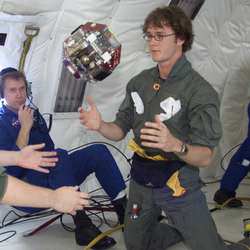
Flight test of a prototype droid by MIT undergrads. Image credit: MIT. Click to enlarge
MIT engineers recently delivered a tiny satellite to the International Space Station. About the size of a soccer ball, this tiny robot is designed to demonstrate how future satellites could be built much much smaller. It’s equipped with a set of carbon dioxide thrusters which allow it to maneuver inside the station. Two additional SPHERES (Synchronized Position Hold Engage Re-orient Experimental Satellites) will be delivered to the station over the next few years to test how they can fly in formation.
Six years ago, MIT engineering Professor David Miller showed the movie Star Wars to his students on their first day of class. There’s a scene Miller is particularly fond of, the one where Luke Skywalker spars with a floating battle droid. Miller stood up and pointed: “I want you to build me some of those.”
So they did. With support from the Department of Defense and NASA, Miller’s undergraduates built five working droids. And now, one of them is onboard the International Space Station (ISS).
“It only looks like a battle droid,” laughs Miller. It’s actually a tiny satellite-the first of three NASA plans to send to the ISS. Together, they’ll navigate the corridors of the space station, learning how to fly in formation.
Tiny satellites are a hot new idea in space exploration: Instead of launching one big, heavy satellite to do a job, why not launch lots of little ones? They can orbit Earth in tandem, each doing their own small part of the overall mission. If a solar flare zaps one satellite – no problem. The rest can close ranks and carry on. Launch costs are reduced, too, because tiny satellites can hitch a ride inside larger payloads, getting to space almost free of charge.
But there’s a problem: Flying in formation is trickier than it sounds. Ask a crowd of people to line up single file, and they’ll be able to figure it out and do it rather easily. Getting a group of orbiting satellites to do the same thing, it turns out, is extremely hard.
“Suppose you’ve got a cluster of satellites in orbit,” says Miller, “and one or two of them lose their place.” Maybe a solar flare temporarily scrambles their nav-computers, or a thruster firing didn’t work as expected. The whole cluster finds itself out of whack. Correcting the problem requires a complex set of 3-dimensional adjustments, coordinated among all the satellites-perhaps dozens or hundreds of them. “We’ve got to break this down into step-by-step, concrete instructions that a computer can understand,” Miller says.
And that takes us back to the ISS:
Miller’s challenge to his undergraduate engineering class back in 1999 was to design a small, roughly spherical robot that could float aboard the ISS and maneuver using compressed CO2 thrusters. The project, called SPHERES (Synchronized Position Hold Engage Re-orient Experimental Satellite), would serve as a testbed for trying out experimental software to control clusters of satellites. The robotic spheres provide a generic platform consisting of sensors, thrusters, communications and a microprocessor; scientists working on new software ideas can load their software into that platform to see how well those ideas work. It’s a quick and relatively cheap way to test new theories on software design.
Possible applications include NASA’s return to the Moon (see the Vision for Space Exploration). One way to build a moonship is to assemble it piece by piece in Earth orbit. “Software designed to control small satellites could just as well be used to maneuver the pieces of a spaceship together,” says Miller.
The first SPHERE arrived on the ISS in April tucked inside a Progress supply rocket. (Remember, tiny satellites make good hitchhikers.) Eventually two more SPHERES will join it, one later this year when the space shuttle Discovery (STS-121) returns to the station, and another carried to orbit by a future shuttle mission.
How will astronauts tell the three SPHERES apart? “They’re color coded,” explains Miller. The one onboard now is red; the second will be blue and the third yellow.
“Red” is already busy. “We’ve commanded it to do a variety of maneuvers-loops and turns, for instance. And we’ve tested the robot’s ability to solve problems.” Astronauts tried to trick Red by causing one of its thrusters to stick “on.” The robot diagnosed the fault, turned the thruster off, and returned to station-keeping.
“Not bad for one little droid,” says Miller. “I can’t wait to see what three of them can do.”
Original Source: NASA News Release
Progress 19 Brings Spare Parts to the Station
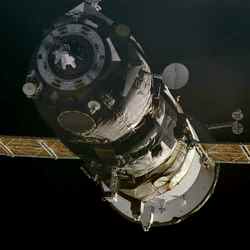
A Progress supply ship. Image credit: NASA Click to enlarge
An unpiloted Russian Progress cargo ship docked to the aft port of the International Space Station (ISS) Zvezda module today at 10:42 a.m. EDT, as the Station flew 220 miles above Central Asia near northern Kazakhstan. The 19th Progress spacecraft to visit the ISS is carrying more than 5,000 pounds of supplies for the crew.
Expedition 11 Commander Sergei Krikalev and Flight Engineer John Phillips will check for leaks before opening the hatch to the Progress later today. They’ll begin unloading the cargo tomorrow.
The supplies include food, fuel, oxygen and air, clothing, experiment hardware, Russian spacesuit components and spare parts for the Vozdukh carbon dioxide removal system. A new water circulation liquids unit is onboard the supply ship. This unit is for the station’s Elektron oxygen-generating system which is inoperable. The unit will be installed next week to try to bring Elektron back into service.
The remainder of the Progress payload includes 1,763 pounds of propellant for the Russian thrusters; 242 pounds of oxygen and air in tanks as a backup supply for the oxygen generated by Elektron; and 463 pounds of water to augment the supplies left by the Space Shuttle Discovery during the STS-114 mission.
Some of the clothing and personal effects delivered to the station include items for the next resident crew, Expedition 12 Commander Bill McArthur and Flight Engineer Valery Tokarev. They are scheduled to launch from the Baikonur Cosmodrome in Kazakhstan Oct. 1 in the Soyuz TMA-7 capsule.
Information about the crew’s activities on board the station, future launch dates, and sighting opportunities is available on the Web at: http://www.nasa.gov/station
Original Source: NASA News Release
Next Station Crew Named
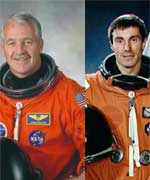
Image credit: NASA
Veteran NASA astronaut John Phillips and seasoned Russian Cosmonaut Sergei Krikalev are the next crew of the International Space Station. Their six-month mission is set for launch in April 2005.
Phillips and Krikalev are the eleventh crew for the orbiting research complex. Krikalev will serve as Station Commander, and Phillips is Flight Engineer and NASA International Space Station Science Officer. Designated Expedition 11, they will be on board the Station when the Space Shuttle makes its first Return to Flight mission. The Shuttle is scheduled to dock with the Space Station in May 2005.
Both crewmembers have previously been to the International Space Station. Phillips flew to the Station aboard the Shuttle on the STS-100 mission in 2001. During that 12-day mission, the crew installed the Canadarm2 Station robotic arm.
In 2000, Krikalev was a member of Expedition 1, the first International Space Station crew. Expedition 11 will be his sixth space flight and fourth long-duration mission. He has the most flights for any Russian cosmonaut.
Selected in 1985, Krikalev flew aboard the Mir Space Station in 1988-89, 1991-92 and the International Space Station in 2000-01. He flew aboard the Shuttle on the first joint U.S.-Russian mission, STS-60 in 1994, and on the first International Space Station assembly mission, STS-88 in 1998. Krikalev has accumulated 625 days in space. At the completion of a six-month stay aboard the Station on Expedition 11, Krikalev will have spent more time in space than any other person.
The Expedition 11 backup crewmembers are astronaut Daniel Tani and cosmonaut Mikhail Tyurin.
For more information about NASA astronauts, Russian cosmonauts, and the Space Station, on the Web, visit:
For information about NASA missions and projects, visit: http://www.nasa.gov
Original Source: NASA News Release
Station Will Get a Better View
Development phase completion of the European-built observation module, or “cupola”, for the International Space Station will be marked by a ceremony at the Alenia Spazio facility in Turin, Italy on Monday 6 September.
The cupola, currently scheduled for launch in January 2009, is an observation and control tower for the ISS, with windows that will provide a panoramic view for observing and guiding operations on the outside of the station.
The pressurised module will accommodate command and control workstations and other hardware, enabling crewmembers to control the station?s robotic arm – for attaching and assembling various station elements – and to communicate with other crewmembers in other parts of the station or outside during spacewalk activities. The cupola will also be used for observational applications in the areas of Earth observation and space science.
The cupola project is the outcome of a bilateral barter agreement between the European Space Agency and NASA, under which ESA is providing the cupola for the ISS in exchange for Shuttle transportation of European equipment and experiments to the station.
The completion of the cupola marks the end of the development phase of the project, which began with the signing of the cupola contract between ESA and Alenia Spazio on 8 February 1999. Under the contract, Alenia Spazio acted as prime contractor for production, responsible for coordinating six other firms: CASA (Spain), APCO (Switzerland), SAAB Ericsson and Lindholmen Development (Sweden), EADS Space Transportation (Germany) and Verhaert (Belgium).
The 1.8-tonne cupola is now ready to be transported to the Kennedy Space Center at Cape Canaveral, Florida. There, it will go through a final set of checks before being put into storage for four years, at the end of which it will be prepared for launch.
Original Source: ESA News Release
Cargo Ship Blasts Off
An unpiloted Russian cargo ship blasted off this morning from the Baikonur Cosmodrome in Kazakhstan on a three-day journey to deliver almost three tons of food, fuel, oxygen, water and supplies to the residents of the International Space Station.
The ISS Progress 15 craft lifted off on time from the Central Asian launch site at 12:03 a.m. CDT (503 GMT), and less than 10 minutes later settled into orbit. Moments after that, automatic commands deployed its solar arrays and navigational antennas.
As the Progress launched, Expedition 9 Commander Gennady Padalka and Flight Engineer and NASA Science Officer Mike Fincke were asleep. The Station was flying just to the southwest of Baikonur at an altitude of 230 statute miles at the time of launch.
Two engine firings were scheduled overnight to raise and refine the Progress? orbit and its path to the ISS for an automated docking Saturday morning at 12:02 a.m. CDT (502 GMT) at the aft port of the Zvezda Service Module. The Progress is loaded with 1521 pounds of propellant, 110 pounds of oxygen and air to replenish the Station?s atmosphere, 926 pounds of water and more than 3000 pounds of spare parts, life support system components and experiment hardware.
Among the spare parts launched today to the Station are new pumps for the U.S. spacesuits onboard that experienced cooling problems in early June while being prepared for a spacewalk to repair a failed power controller. The suits are undergoing troubleshooting in the hope they can be placed back into service in the near future. The repair spacewalk was eventually conducted in Russian Orlan spacesuits on June 30.
Also on the Progress are clothing articles for the next residents that will occupy the Station. Expedition 10 Commander and NASA Science Officer Leroy Chiao and Flight Engineer Salizhan Sharipov are scheduled to launch Oct. 9 on the Soyuz TMA-5 vehicle from Baikonur to begin a six-month stay on the complex, replacing Padalka and Fincke.
Information on the crew’s activities aboard the Space Station, future launch dates, as well as Station sighting opportunities from anywhere on the Earth, is available on the Internet at:
Details on Station science operations can be found on an Internet site administered by the Payload Operations Center at NASA’s Marshall Space Flight Center in Huntsville, Ala., at:
The next ISS status report will be issued on Friday, August 13, or earlier, if events warrant.
Original Source: NASA Status Report
Progress 14P Docks With Station

Image credit: NASA
An unmanned Russian resupply ship smoothly linked up to the International Space Station this morning, delivering two and a half tons of food, water, fuel, spare parts and supplies to the two residents on board.
With Expedition 9 Commander Gennady Padalka and NASA Science Officer and Flight Engineer Mike Fincke looking on, the ISS Progress 14 docked to the aft port of the Zvezda Service Module at 8:55 a.m. CDT (1355 GMT) as the two craft flew 230 statute miles above Central Asia.
Padalka and Fincke were in Zvezda, prepared to take over manual control of the operation if it had been necessary, but the Progress craft automatically docked to the module through pre-programmed computer command with no problem.
The Progress was launched Tuesday from the Baikonur Cosmodrome in Kazakhstan and chased the Station for two days, using its engine to conduct rendezvous maneuvers in fine-tuning its course for today?s docking.
The Progress was the first ship to arrive at the ISS since Padalka and Fincke took over Station operations last month. The next Progress is scheduled to launch to the Station in late July.
After leak checks are completed to insure a tight seal between Progress and Zvezda, Padalka will open up the ship?s hatch later today so he and Fincke can begin unloading its cargo Friday.
Next week, Padalka and Fincke will turn their attention to preparations for a spacewalk no earlier than June 16, Moscow time, in Russian Orlan spacesuits out of the Pirs Docking Compartment to replace a power controller on the Station?s truss that failed April 21, resulting in the temporary loss of one of the four Control Moment Gyros (CMGs) that govern the orientation of the complex.
On Wednesday, Fincke and Padalka took turns maneuvering the Station?s Canadarm2 robotic arm to a position along the S0 Truss for camera views of the spacewalk worksite and downlink television of the spacewalk tasks as they are conducted during the planned 4-? hour excursion. The two crewmembers will begin checking out their Orlan spacesuits next Thursday and are expected to climb into the suits June 11 in a dress rehearsal of the suit up and a thorough checkout of the suit systems that will clear the way for the spacewalk.
The spacewalk will be under the control of both U.S. and Russian mission personnel. Russian flight controllers will be directing Padalka and Fincke as they exit the Pirs and climb onto the telescoping Russian Strela cargo crane to be transported some 50 feet to the intersection of the U.S. and Russian segments of the Station. Once they dismount from the Strela, Padalka and Fincke will be under the direction of U.S. flight controllers as they move to the S0 Truss via handrails and tethers to swap out the failed Remote Power Control Module (RPCM) that rendered CMG 2 inoperable.
After power is restored to the CMG, the spacewalkers will make their way back to the Strela crane and, under the direction of Russian flight controllers once again, will swing back to the Pirs to reenter the Russian airlock and end the spacewalk.
Padalka and Fincke also conducted biomedical experiments and routine housekeeping tasks this week as they set their sights on the start of spacewalk preparations.
Information on the crew’s activities aboard the Space Station, future launch dates, as well as Station sighting opportunities from anywhere on the Earth, is available on the Internet at:
Details on Station science operations can be found on an Internet site administered by the Payload Operations Center at NASA’s Marshall Space Flight Center in Huntsville, Ala., at:
The next ISS status report will be issued on Friday, June 4, or earlier, if events warrant.
Original Source: NASA News Release
Progress Launches to Supply Station
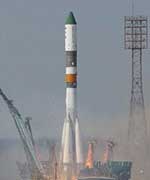
Image credit: Energia
In compliance with the International Space Station (ISS) flight program and obligations of the Russian Party under the ISS Project rocket and space complex Soyuz-U/Progress M-49 was launched at 16:34:23 Moscow summer time from Baikonur cosmodrome.
The aim of the launch is to deliver necessary cargoes to the ISS to continue operation of the Orbital Complex and create habitation and working conditions for the crew.
According to the ISS assembly program, the Progress M-49 flight designation is 14P.
The refueling compartment of Progress M-49 contains about 640 kg of propellant, 28 kg of oxygen, 20 kg of air, 420 kg of potable water. Its cargo compartment accommodates about 1.2 tons of dry cargoes including food products, equipment and aids for the station onboard systems, individual protection gear, sets of crew procedures, video and photo equipment, parcels for the crew, structural elements, payloads for the US On-Orbit Segment, hardware and materials for space experiments.
The vehicle was launched into orbit with maximum altitude of 252.0 km, minimum altitude of 193.1 km, period of revolution of 88.65 min and inclination of 51.66?.
The vehicle onboard systems operate normally.
The vehicle and ISS docking is scheduled on 27 May 2004 with berthing to the axial docking port of Russian Service Module Zvezda. The estimated time of the docking assembly contact is 17:55. Cargo vehicle Progress M1-11, that has been operating as part of the Orbital Complex since 31 May 2004, cleared the docking port on 24 May 2004. This vehicle that was transferred to a safe distance after the docking will continue its on-orbit flight during the following ten days under a permanent control of MCC-M specialists, supporting performance of the science experiments under the autonomous flight program. Following that, it will be transferred to the descent trajectory and deorbit in the assigned area of the Pacific Ocean.
The decision about complex Soyuz-U/ProgressM-49 launch was taken by the Government Board (co-chairmen: N.F. Moiseev, V.A. Grin’) based on the conclusion of the Technical Management about the readiness of the Space Complex and ground infrastructure components involved in the ISS program implementation.
The prelaunch processing was directly led by the Technical Management (Yu.P. Semenov, Technical Manager of Russian Piloted Space Programs, General Designer of S.P. Korolev RSC Energia, Academician of the Russian Academy of Sciences).
The vehicle and Space Station flight is under control of the Lead Operational Control Team (LOCT) located in the Mission Control Center in Moscow (MCC-M), Korolev, Moscow area (Flight Director is pilot-cosmonaut V.A. Soloviev, S.P. Korolev RSC Energia).
The ISS Orbital Complex operates in orbit with the following parameters: maximum altitude of 385.6 km, minimum altitude of 359.5 km, period of revolution of 91.8 min and inclination of 51.65?. The Russian Segment consists of Functional Cargo Module Zarya, Service Module Zvezda, docking module Pirs, manned transport spacecraft Soyuz TMA-4. The US On-orbit Segment consists of modules Unity and Destiny, airlock Quest, multi-link truss structure with deployed solar arrays. Total mass of the ISS is about 175.2 tons.
According to the telemetry information and reports made by the ISS Expedition 9 crew (ISS-9): Russian cosmonaut Gennady Padalka (commander) and US astronaut Mike Fincke (flight engineer), all station onboard systems operate in the designed modes.
The Space Station is ready for docking with a new cargo vehicle.
Original Source: Energia News Release
Japanese Celebrity Will Visit the Space Station
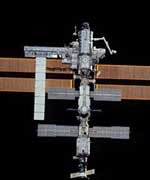
Image credit: Space Adventures
Space Adventures, Ltd., the world’s leading space experiences company, announced today it has begun working with Dentsu, the world’s largest advertising agency, to send a prominent Japanese figure to the International Space Station (ISS) within the next several years.
As part of the agreement with Dentsu, Space Adventures will dedicate one of the four seats the company has available on the Russian Soyuz TMA spacecraft. Space Adventures currently has a contract with the Federal Space Agency of Russia that provides them with the sole rights to transport the next four private space explorers to the ISS. The first of the four seats has already been contracted by American technology entrepreneur, Greg Olsen, Ph.D., who is currently training at the Yuri Gargarin Training Center in Star City, Russia. His expedition is currently planned for April 2005. With two of the four seats committed, Space Adventures has two seats remaining on the Soyuz.
“I welcome the opportunity to work with Dentsu. They are the world’s premier advertising agency and we are delighted to embark on such an exciting opportunity with them,” said Eric Anderson, president and CEO of Space Adventures. “As Dentsu has cultivated unique artistic designs and opportunities for advertising in today’s marketplace, we, at Space Adventures, are using the same enthusiasm and innovative techniques to open the space frontier to private citizens. Together, we will make history by sending the first Japanese private explorer to space.”
About Space Adventures: The world’s leading space flight experiences and space tourism company offers a wide range of programs from Zero-Gravity and Edge of Space flights, cosmonaut training and space flight qualification programs to reservations on future suborbital spacecraft. Headquartered in Arlington, Va., with an office in Moscow, Space Adventures is the only company to have successfully launched private individuals to the ISS. The company’s advisory board comprises Apollo 11 moonwalker Buzz Aldrin, shuttle astronauts Kathy Thornton, Robert (Hoot) Gibson, Charles Walker, Norm Thagard, Sam Durrance and Byron Lichtenberg and Skylab astronaut Owen Garriott.
About Dentsu Inc.: Founded in 1901, Dentsu is the largest advertising agency brand and the fifth largest marketing and communications organization in the world. Based in Tokyo, Dentsu offers national, multinational and global clients the most comprehensive range of advertising and marketing services through its unique “Total Communications Services” approach. Dentsu has pioneered and set global standards for integrated communications, which in latter years have been adopted by a number of major international networks. The group has more than 6,000 clients and 14,245 full-time employees in both Japan and in its offices overseas. Consolidated billings (net sales) for fiscal term 03/04 were recorded at 1,749 billion yen. Dentsu is publicly quoted on the Tokyo Stock Exchange. For more information, please visit www.dentsu.com.
Original Source: Space Adventures News Release
